
Asteroids is a space-themed multidirectional shooter arcade video game designed by Lyle Rains and Ed Logg released in November 1979 by Atari, Inc. The player controls a single spaceship in an asteroid field which is periodically traversed by flying saucers. The object of the game is to shoot and destroy the asteroids and saucers, while not colliding with either, or being hit by the saucers' counter-fire. The game becomes harder as the number of asteroids increases.

The Atari 8-bit computers, formally launched as the Atari Home Computer System, are a series of 8-bit home computers introduced by Atari, Inc. in 1979 with the Atari 400 and Atari 800. It is the first home computer architecture with coprocessors, enabling more advanced graphics and sound than most of its contemporaries. Video games are key to its software library, and the 1980 first-person space combat simulator Star Raiders is considered the platform's killer app.
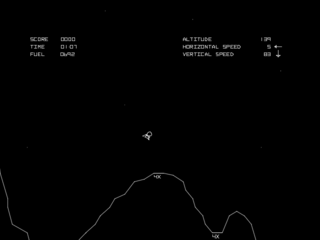
Lunar Lander is a genre of video games loosely based on the 1969 landing of the Apollo Lunar Module on the Moon. In Lunar Lander games, players control a spacecraft as it falls toward the surface of the Moon or other astronomical body, using thrusters to slow the ship's descent and control its horizontal motion to reach a safe landing area. Crashing into obstacles, hitting the surface at too high a velocity, or running out of fuel all result in failure. In some games in the genre, the ship's orientation must be adjusted as well as its horizontal and vertical velocities.

Choplifter is a military themed scrolling shooter developed by Dan Gorlin for the Apple II and published by Broderbund in 1982. It was ported to Atari 8-bit computers the same year and also to the VIC-20, Commodore 64, Atari 5200, ColecoVision, MSX, and Thomson computers.

Star Trek is a text-based strategy video game based on the Star Trek television series (1966–69) and originally released in 1971. In the game, the player commands the USS Enterprise on a mission to hunt down and destroy an invading fleet of Klingon warships. The player travels through the 64 quadrants of the galaxy to attack enemy ships with phasers and photon torpedoes in turn-based battles and refuel at starbases. The goal is to eliminate all enemies within a random time limit.

A type-in program or type-in listing was computer source code printed in a home computer magazine or book. It was meant to be entered via the keyboard by the reader and then saved to cassette tape or floppy disk. The result was a usable game, utility, or application program.

Compute!, often stylized as COMPUTE!, was an American home computer magazine that was published from 1979 to 1994. Its origins can be traced to 1978 in Len Lindsay's PET Gazette, one of the first magazines for the Commodore PET computer. In its 1980s heyday, Compute! Covered all major platforms, and several single-platform spinoffs of the magazine were launched. The most successful of these was Compute!'s Gazette, which catered to VIC-20 and Commodore 64 computer users.
John J. Anderson or J.J. Anderson was a writer and editor covering computers and technology. The New Jersey native was Executive Editor of Computer Shopper and Atari Explorer. At the time of his death he was an editor for MacUser magazine in Foster City, California. He was 32, and was survived by a wife, Lauren Hallquist Anderson, and two children.
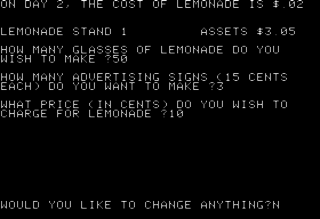
Lemonade Stand is a business simulation game created in 1973 by Bob Jamison of the Minnesota Educational Computing Consortium (MECC). In it, the player moves through several rounds of running a lemonade stand, beginning each round by making choices dependent on their current amount of money about their stock, prices, and advertising. In each round, the results are randomized based on the player's inputs, as well as affected by random events such as thunderstorms and street closures. Each round ends with a summary of the player's current status, and the game ends after 12 rounds.

Basic Math is an educational video game for the Atari Video Computer System. The game was developed at Atari, Inc. by Gary Palmer. The game involves a series of ten arithmetic problems involving addition, subtraction, multiplication, or division. The player can edit different gameplay modes to alter how the numbers in the problem are chosen, or if their questions are timed. The game was released in 1977 as one of the earliest releases for the console.

Computer Bismarck is a computer wargame developed and published by Strategic Simulations, Inc. (SSI) in 1980. The game is based on the last battle of the battleship Bismarck, in which British Armed Forces pursue the German Bismarck in 1941. It is SSI's first game, and features turn-based gameplay and two-dimensional graphics.
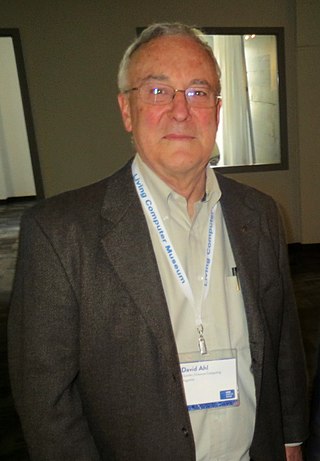
David H. Ahl is an American author who is the founder of Creative Computing magazine. He is also the author of many how-to books, including BASIC Computer Games, the first computer book to sell more than a million copies.

Starfleet Orion is a 1978 science fiction strategy game written and published by Automated Simulations. It appears to be the first space-themed strategy game sold for microcomputer systems. The game was originally written in BASIC for the Commodore PET, but later ported to other early home computer platforms including the TRS-80 and Apple II. The game was something of a success, leading to a string of successes for the company, notably the major hit Temple of Apshai.

Following the introduction of the IBM Personal Computer, or IBM PC, many other personal computer architectures became extinct within just a few years. It led to a wave of IBM PC compatible systems being released.

BASIC Computer Games is a compilation of type-in computer games in the BASIC programming language collected by David H. Ahl. Some of the games were written or modified by Ahl as well. Among its better-known games are Hamurabi and Super Star Trek.

Planet Miners is a game published by the Microcomputer Games division of Avalon Hill for the TRS-80 Level II microcomputer in 1980. It was ported to the Atari 8-bit computers, Apple II, and Commodore PET. The game is written in BASIC.
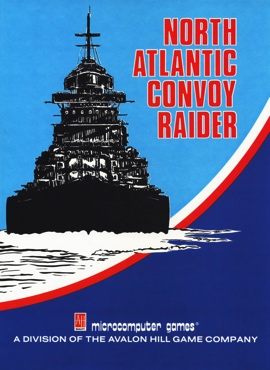
North Atlantic Convoy Raider is a wargame published by Microcomputer Games for TRS-80, Commodore PET, and Apple II in 1980. A version for Atari 8-bit computers was released in 1981.
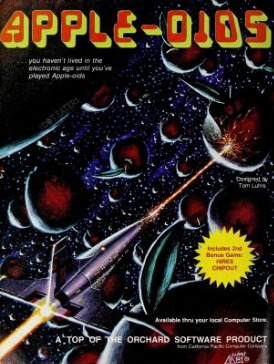
Apple-Oids is a clone of Atari, Inc.'s Asteroids arcade video game. It was written by Tom Luhrs for the Apple II and published by California Pacific Computer Company in 1980. The asteroids in Apple-oids are in the shape of apples.

ABM is a clone of Atari, Inc.'s Missile Command arcade game for the 32K Apple II. It was programmed by Silas Warner and published by Muse Software in 1980, the same year as Missile Command.
BASIC-8, is a BASIC programming language for the Digital Equipment (DEC) PDP-8 series minicomputers. It was the first BASIC dialect released by the company, and its success led DEC to produce new BASICs for its future machines, notably BASIC-PLUS for the PDP-11 series. DEC's adoption of BASIC cemented the use of the language as the standard educational and utility programming language of its era, which combined with its small system requirements, made BASIC the major language during the launch of microcomputers in the mid-1970s.




















